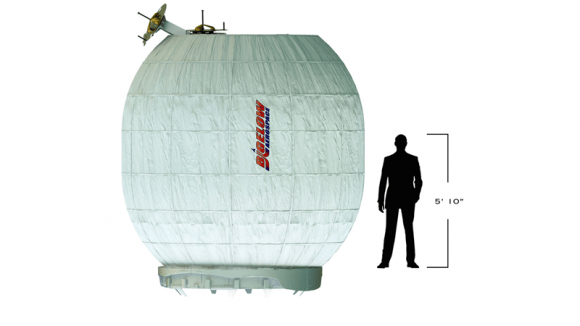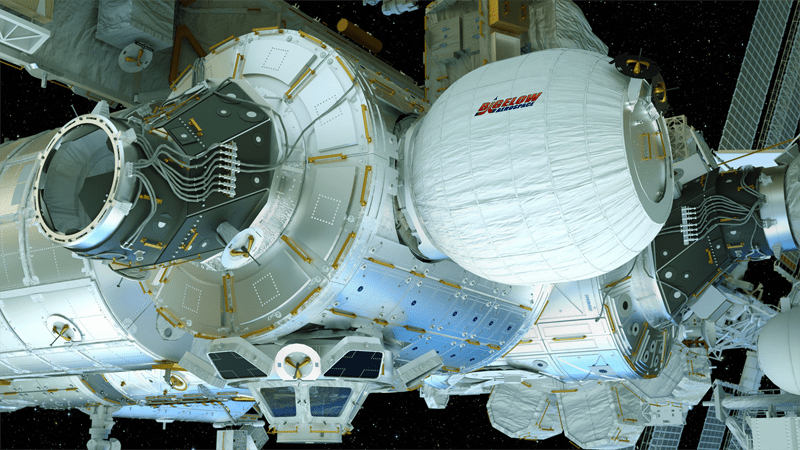Space habitats have long been an object of fascination for thinkers, dreamers, and engineers. Science fiction is littered with space habitats, whether in books or movies. And their designs have ranged from titanic, uber-engineered types to fanciful, organic types.
Bigelow Aerospace is one company that is focused on creating affordable, practical space habitats. Inflatability is the name of the game for Bigelow, and now, one of their habitat modules is going to be tested on the ISS for a 2-year period. The BEAM, or Bigelow Expandable Activity Module, will be launched aboard a SpaceX Dragon on Friday April 8th, for a 2-day journey to the ISS.
The BEAM travels as an 8 foot bundle, but once it’s attached to the ISS, and inflated by astronauts, it will be large enough to hold a car. However, astronauts won’t be living inside it; rather, the BEAM will be tested for 2 years to see how it holds up. The objectives for this 2 year mission include:
- Demonstrating launch and deployment, as well as folding and packing techniques.
- Determining radiation protection capability.
- Demonstrating design performance such as thermal, structural, mechanical durability, long-term leak performance, etc.
- Increasing Technology Readiness Level (TRL) of expandable habitat technology

“The International Space Station is a uniquely suited test bed to demonstrate innovative exploration technologies like the BEAM,” said William Gerstenmaier, associate administrator for human exploration and operations at NASA Headquarters in Washington. “As we venture deeper into space on the path to Mars, habitats that allow for long-duration stays in space will be a critical capability. Using the station’s resources, we’ll learn how humans can work effectively with this technology in space, as we continue to advance our understanding in all aspects for long-duration spaceflight aboard the orbiting laboratory.”
The obvious risk to an inflatable space habitat is puncturing; not only from meteoroids, but from the growing population of space junk that inhabits Earth’s orbit. But BEAM is designed with this hazard in mind. It’s a thick-walled design, made from multiple layers of fabric similar to Kevlar. As far as space junk goes, BEAM should be impenetrable.
The BEAM is just a test module. It will hold only monitoring equipment, and will be entered by astronauts retrieving data and performing inspections. Bigelow Aerospace’s design for a usable habitat is the B330, a module large enough for 6 occupants, with a projected lifespan of 20 years. Test results from BEAM’s 2 years in space will help refine the design of the B330.
After its 2 years are up, BEAM will be released from the ISS and will be destroyed when it enters Earth’s atmosphere.


“As far as space junk goes, BEAM should be impenetrable.” How can that be possible? Surely there is space junk of such size, shape and relative velocity that ANY containment can be punctured if not destroyed.
When are astronauts or space tourists finally going to be inside a Bigelow inflatable module? They’ve been in the space news for years, but the development seems to be going at snail’s pace.
BEAM looks kind of like the ‘Pillsbury Dough Boy’ of ISS habitat modules? LOL… But seriously, this is a very cool project and I hope it works as planned. Next, I’d like to see an inflatable torus/doughnut shaped hab module spun up to simulate gravity for Mars transit. Live in it during transit then convert it into a Mars entry aeroshell/balloot. Land the thing and reconfigure it once again into a surface habitat.
Sure, that’s putting all the ‘eggs in one basket’, but if it works, it would be a MUCH lighter and multi functional basket indeed!
any (space) tent should go with a proper (space) campfire.
Lets see if those two go hand in hand in space as well.
Isn’t that right Cygnus? 😉
Can we roast some space marshmallows as well?
Mmm. Pan fried sandtrout. Aghghg…